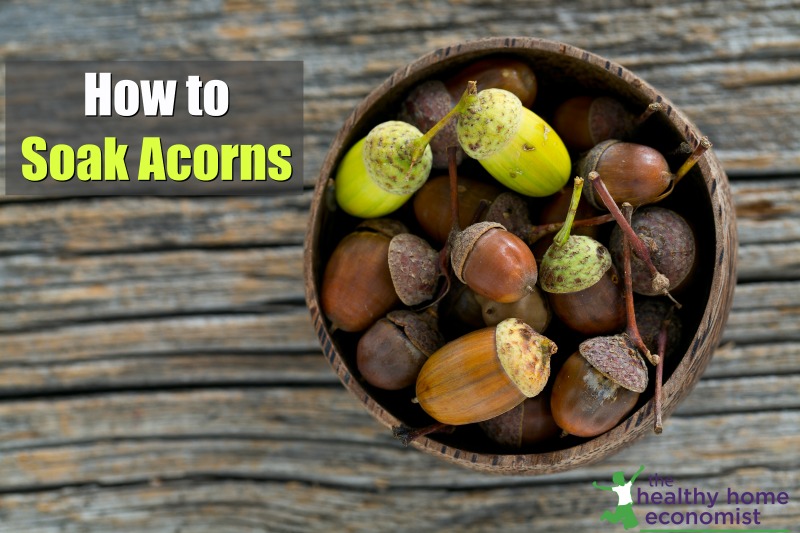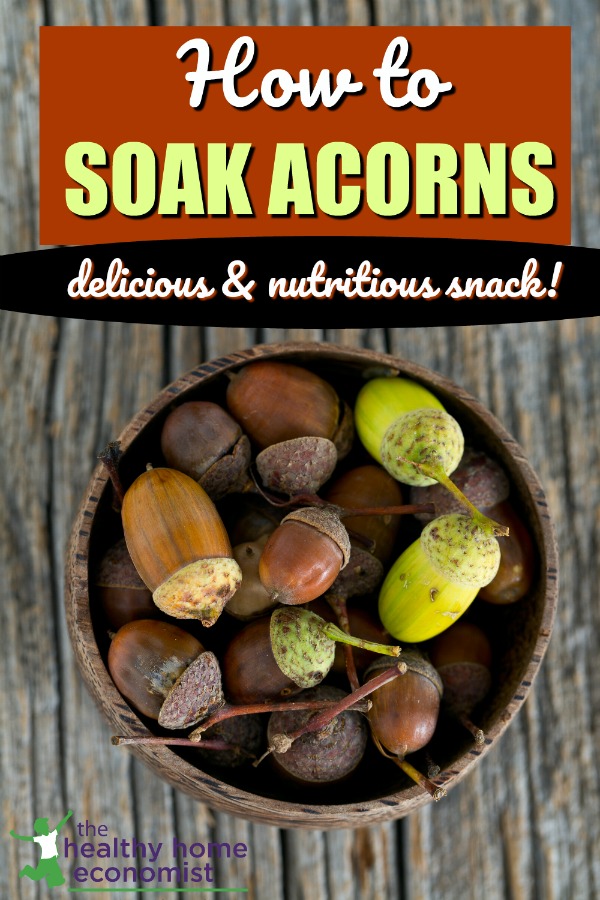Table of Contents[Hide][Show]

Most people do not realize that the millions of acorns that fall every Autumn in the Northern Hemisphere are very nutritious and good to eat!
In fact, of the top 12 culinary nuts, acorns rank in the top half for overall nutrition and the healthiest fatty acid profile.
The only catch is that they must be soaked or “leached” first otherwise they are inedible from the intensely bitter taste. If you ever tried to nibble on a raw acorn as a kid (yes, I tried it once…hey, the squirrels loved them, right?), no doubt you immediately spit it right out.
Bitter and astringent, the tannic acid in acorns is easily removed by soaking them in water. The leaching process also eliminates phytates too, another powerful type of anti-nutrient present in all nuts that blocks mineral absorption in the intestines. (1)
Leaching Acorns
There are two methods of leaching that work to remove anti-nutrients from acorns:
- Hot leaching
- Cold leaching
Choose the method that works best for you based on how you intend to eat the acorns…whole or as flour.
Hot Leaching
The benefit of hot leaching is speed. It takes just a few hours to complete. The process is similar to boiling peanuts.
- Let the acorns dry out until they become hard and have a slight “rattle” inside. This takes about 3 days in the sun. Alternatively, you can dry them on low heat in a warm oven for a couple of hours. This makes them easier to shell.
- Shell the acorns with a hammer or nutcracker and place them in a large pot with filtered water to cover. Compost the discarded shells.
- Bring the water to a boil, turn the heat down to a simmer, put on the lid, and cook for 5 hours.
- Add more water as needed during the simmering process to ensure the acorns are completely covered throughout.
The drawback of hot leaching is that the meat of the acorns turns very dark during the hours-long boiling. This destroys enzymes, some nutrients, and a beneficial starch in the acorns that acts like gluten but doesn’t generate the same allergic reactions.
This starch is helpful as a binder when baking with acorn flour is the goal. (2)
Thus, if you intend to make acorn flour and do some baking with your acorn haul, be sure to use cold leaching as described below.
Save the hot leaching for when you intend to snack on the acorns whole.
Cold Leaching
Traditionally, cold leaching was the preferred method for home processing of acorns.
While much slower, it preserves enzymes and some nutrients by maintaining the rawness of the acorns. The important binding starch in acorns is preserved also. Thus, this method is preferred when making acorn flour.
Cold leaching can take up to a week depending on the size of the acorns but produces a superior final product in both taste and nutrition.
- Dry the acorns until they become hard and have a slight “rattle” inside (about 3 days in the sun). Alternatively, you can dry them on low heat in a warm for a couple of hours. The next step is much easier if you dry them out a bit.
- Shell the acorns (use a hammer or a nutcracker), place them in a large pot and fill with enough cold filtered water to cover. Compost the discarded shells.
- Drain the pot and fill it with fresh water daily.
While the phytic acid is removed quickly within just a few hours of soaking, the tannins take longer.
Once the soaking water no longer turns brown over a 24-hour period, the bitter tannins are gone and the acorns are safe to eat!

Rinse
Whether you choose to use hot or cold leaching, the acorns must be thoroughly rinsed afterward.
This ensures that any residual soaking water that contains the bitter tannins does not dry on the acorns. This ensures the best flavor and digestive experience.
Dehydrate
After leaching, acorns must be thoroughly dried. This is the case whether you intend to eat them whole or process into acorn flour.
A food dehydrator works very well for this process. If you don’t have one of these appliances, no worries! My favorite method to dry nuts is actually to use the “warm setting” on the oven which keeps the temperature at or below 150 °F/66 °C.
Evenly spread the acorns on cookie sheets, place them on the oven racks, and turn the setting to “warm” for several hours until the acorns are dry to the touch.
If you live in a warm location, drying in the hot sun works too. Note that drying the acorns is an important step, as wet acorns will rapidly mold.
Storage
Dried acorn nuts are best stored in an airtight container in the refrigerator or a cool, dark pantry. They will be good to eat for weeks!
If you choose to immediately grind the dried acorns into flour, it is very important to refrigerate the flour in a sealed container rather than store in the pantry. The nutrients in the acorns are much more vulnerable once processed into flour. Try to use refrigerated flour within a week after grinding to avoid nutrient degradation.
References
(1) The Incredible, Edible Acorn
(2) How to Make Acorn Flour








Thanks so much. As with other nuts, do you add sea salt? If so, how much salt for how much/weight of acorns?
There’s a missing word, probably “oven”, in this sentence:
“Alternatively, you can dry them on low heat in a warm for a couple of hours.”
Great article, thank you!
I used acorns from our Pin Oak which is a red oak. I read in one of our Missouri conservation magazines that acorns from white oaks, swamp white oak and bur oak, have a sweeter tasting nut. The acorns from the red oak need to be boiled in at least ten changes of water. The Red Oak group has more “tannin”
than the white oak group.I’ve been soaking my Pin oak acorns for over a month now. After about 2 weeks I started changing the water twice a day. They were still bitter. So I cut them all in half. A week or so later I cut them In quarters. I’ve been soaking them since January 27th.Today is March 2nd. I’m not quitting after I’ve gone this far! I just noticed my instructions said to chop them (white or red). I agree- that would soak the tannins out quicker.A few weeks ago I cut them in half and a week or so later I quartered them! They are finally almost there. The ones I boiled, I boiled a couple of days. They taste good. I dehydrated them in my dehydrater. They are a little hard but taste good! Next time I will try acorns from a bur oak which is a white oak.I will do a small batch to see how it goes. It has been a long process but I enjoy trying things in the wild and something new. Also our conservation magazine points out that a diet of too many acorns have proven fatal to many cows. It also stated that Pioneers made flour from white acorns and mixed with their other flours, thus stretching the flour source to make it through winter. Just make sure you soak out the bitter taste. Thanks for posting your instructions! I have enjoyed this experience and never knew before that acorns could be eaten.
Thank you for this article. My son has done the hot processing method years before and we baked with it. Looking forward to trying the cold method soon. I do wonder how long the uncracked acorns would last for (possibly) mid-winter processing?
That’s a good question … other types of nuts like pecans stay good in the shell for up to 4 months, so I’m guessing acorns would be a similar timeframe.
In CA we have a different type of acorn from our oak trees. Would these also be safe to eat? We have tons! Thank you.
All North American oak trees (there are dozens of species!) have acorns that are good to eat when soaked properly first. Some taste better than others, though. We have tiny ones here in my neighborhood, but the bigger ones are fine too from other places.